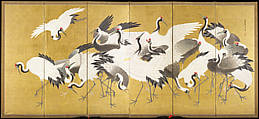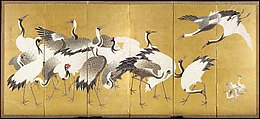Returned to lender The Met accepts temporary loans of art both for short-term exhibitions and for long-term display in its galleries.
Flock of Cranes
Ishida Yūtei Japanese
Not on view
A multitude of cranes strut or fly across a gold-leaf background, creating a subtly textured tableau of white, black, and gray, with accents of red. At the center, the pair of cranes keeping a careful eye on their two chirping chicks symbolizes marital fidelity and blissful family life—the reason why cranes were more commonly represented on wedding garments and dowry objects than any other animal motif.
The artist has depicted at least three different types of cranes native to Japan. The one most frequently portrayed by artists, including Yūtei, is the red-crowned crane (tanchō-zuru), which has a tall, stately, white-feathered body with a crest of red feathers—this is the species of the parents and baby cranes just mentioned. The white-naped crane (mana-zuru), as its name implies, has a white neck, silvery plumage, and an orb of red feathers surrounding its eyes. The hooded crane (nabezuru) has grayish plumage, sometimes with a small splash of red feathers above its eyes.
The attention to proper ornithological detail is a reminder that Yūtei was the teacher of celebrated Kyoto artist Maruyama Ōkyo (1733–1795), renowned for making naturalist depictions of flora and fauna central to the corpus of the school he founded.
Due to rights restrictions, this image cannot be enlarged, viewed at full screen, or downloaded.
This artwork is meant to be viewed from right to left. Scroll left to view more.



